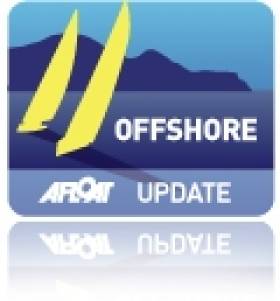Displaying items by tag: Cork Harbour Marina
#hugoboss – Alex Thomspon's Hugo Boss Yacht that called into Cork Harbour marina en route to New York from Southampton in late April has broken its mast during the Atlantic Crossing.
Last Friday morning whilst sailing upwind at 25 knots, the team progress to New York has been interrupted when their mast broke. The reason for the broken mast is currently unknown; however, the on-board team, which includes skippers Alex Thomson, Pepe Ribes, Ryan Breymaier and crewmember, Willy Altadill are all safe and have stabilized the mast. Alex has reported that there is no damage to the boat or sails and they will continue to Newport, Rhode Island. T
The broken section has been secured and the boat is able to sail with the remaining mast and they are on route to Newport RI. At the moment our intention is to make a suitable repair to allow Pepe and Ryan to take part in the New York to Barcelona Race race but until the boat is in port and fully assessed we cannot finalise our plans.
The team website says: 'the mast was broken above the top spreader. We are relieved to announce that the four crew members on-board are safe and we have notified their families and our sponsors'.
In April, the Open 60 made a surprise visit to Cork Harbour Marina in Monkstown Bay, giving some 50 local junior sailors a tour of the vessel - and hopefully inspiring their future in offshore racing.
Skipper Alex Thomson said he and his crew were not far off Land's End in Cornwall after a leak discovered in the starboard ballast tank required overnight repairs.
But rather than sail back to Falmouth, Thomson reckoned they could find a suitable deep-water berth on Ireland's south coast.
A few phone calls later from the team's business manager (and Corkonian) Stuart Hosford, and they had a place waiting for them in Monkstown Bay, which can boast of over eight metres of water at low tide - more than enough for a vessel of Hugo Boss' stature.
Hugo Boss Open 60 Stops Off At Cork Harbour Marina
#Offshore - The Open 60 Hugo Boss made a surprise visit to Cork Harbour Marina in Monkstown Bay at the weekend, giving some 50 local junior sailors a tour of the vessel - and hopefully inspiring their future in offshore racing.
Skipper Alex Thomson said he and his crew were not far off Land's End in Cornwall after a leak discovered in the starboard ballast tank required overnight repairs.
But rather than sail back to Falmouth, Thomson reckoned they could find a suitable deep-water berth on Ireland's south coast.
A few phone calls later from the team's business manager (and Corkonian) Stuart Hosford, and they had a place waiting for them in Monkstown Bay, which can boast of over eight metres of water at low tide - more than enough for a vessel of Hugo Boss' stature.
"We could not believe it when we found a welcoming committee on the dock when we arrived at 3.30am on Saturday," said Thomson.
"The marina owner, James O’Brien, was there to help us dock and some Monkstown Bay Sailing Club members took us up the Boson Guest House, where they had reserved rooms for us whilst we were still at sea."
After a hearty cooked breakfast, and a free lunch from Hassett's Bakery in Carrigaline, Thomson and crew found they were the "star attraction" in Monkstown "with a steady flow of visitors who just wanted to see the boat while we worked on it".
When the team hauled up the mainsail to check the rigging they inadvertently made a new addition to Cork Harbour's skyline, even blocking out the view of Cobh Cathedral!
But it wasn't all work for Thomson and company, as the skipper said Sandy Rimmington and other club members were on hand to help with repairs "and we were able to relax in the club on Sunday night, drinking stout until all hours with local sailors and the survivors from watching the Munster match in the afternoon."
Before the Open 60 departed yesterday (28 April) en route across the Atlantic to New York, Thomson described their impromptu visit to Cork Harbour as "one of those serendipitous incidents. We were lucky to be near Monkstown when we ran into a problem, rather than mid-Atlantic. What a great place to have to visit by accident!"
He also expressed his hope that "the next phase of development for the marina will go ahead and yachts such as ourselves will be able to use the facilities again in the future.
"With this development in place, Monkstown and Cork Harbour will be much more attractive to play host to a major international race. It is ideally located as a base and destination for offshore racing."






























































